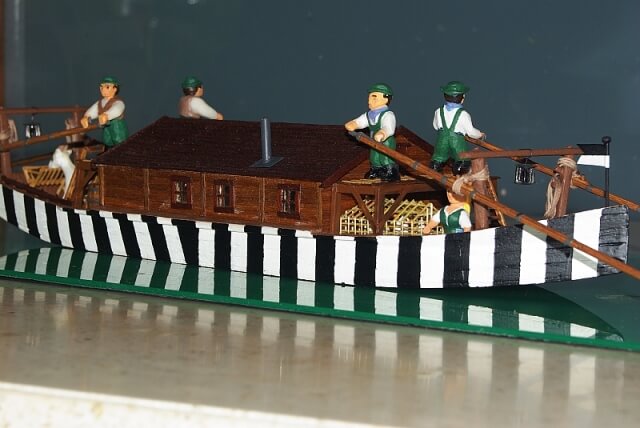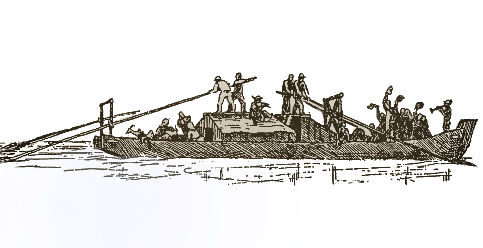⚓ Ulmer Schachtel ⚓
 german river barge ca. 1750
german river barge ca. 1750



 A hajó története
A hajó története
(Sulinet.hu)

Ez a 18. században Ulmban (a Duna mellett) ácsolt teherszállító dereglye kb. 60 láb hosszú, 15 láb széles és 3 láb mély volt (1 láb = 31.3 cm). A lapos törzsnek normál vízállásnál kb. 20 tonna volt a teherbírása.
Az utazási sebességet a Duna sodrása határozta meg. A Dél-Magyarországra történő utazás (kizárólag nappal) több napot vett igénybe, ami a zátonyok, valamint az esetenkénti magas vízállás miatt nem volt veszélytelen vállalkozás. A legénység 6-8 főből állt.
Egy dereglye kb. 200 guldenbe került, az utazásért 20 guldent kellett fizetni.
A célállomáson ezeket az "egyutas dereglyéket" szétszedték, a fát pedig eladták, mivel árral szembeni vontatása nem volt lehetséges.
Ily módon került sok ezer Duna menti sváb a kiürült országba, amelyből kevesebb mint 100 év alatt virágzó kertet hoztak létre.
 Die ulmer Schachtel um 1750 (Sulinet.hu) und (Vikipedia)
Die ulmer Schachtel um 1750 (Sulinet.hu) und (Vikipedia)

Diese im 18. Jahrhundert in Ulm/Donau geschopperten Zillen (Schopper = Bootsbauer) waren ca. 60 Fuss lang, 15 Fuss breit und 3 Fuss tief (1 Fuss = 31,3 cm).
Der flache Rumpf hatte eine Tragfähigkeit von maximal ca. 20 Tonnen bei optimalem Wasserstand.
Die Reisegeschwindigkeit wurde von der Strömung der Donau bestimmt. Eine Fahrt (nur bei Tageslicht) nach Südungarn dauerte mehrere Tage und war wegen Felsen oder bei Hochwasser nicht ungefährlich. Zur Bedienung waren 6-8 Männer nötig.
Eine Zille kostete ca. 200 Gulden, für die Passage mussten 20 Gulden bezahlt werden.
Am Zielort angekommen wurden diese "Einweg-Zillen" zerlegt und das Holz verkauft, da ein flussaufwärts "Treideln" (ziehen gegen den Strom) nicht möglich war.
So kamen viele Tausend "Donauschwaben" in das leere Land und machten in weniger als 100 Jahren einen blühenden Garten daraus.

 The History of the small barge typical of Ulm called Ulmer Schachtel (lanajim.com)
The History of the small barge typical of Ulm called Ulmer Schachtel (lanajim.com)

Together with the Ulmer Münster (cathedral) and the Ulm sparrow, the Ulmer Schachtel ("Ulm Box") stands as a symbol for the city of Ulm. It is a special, flat river boat which transported passengers and goods down the Danube from the 16th century onwards. The correct word for this kind of boat in German is "Zille", but in Stuttgart somebody gave the boat its characteristic nickname "Schachtel" (which means "box"). The boat has a black and white painting which could refer to Ulm's city colors and coat of arms, but not only in Ulm the boats have this painting with black tar color and the natural white of the fir wood.
Already in early times, navigation on the Danube occupied an important position in the commercial life of the city of Ulm. In the past, numerous rafts descended the Iller from the well-wooded Allgäu. In order to transport persons and fragile or perishable goods, one had to fit these rafts with superstructures before they could continue their journey.
In the Middle Ages, this was the usual way to transport salt, linen, fustloan and hardware down the Danube. As the circumstances of the 16th century demanded a more regulated navigation, the inhabitants of Ulm set to put shipbuilding on a professional basis. They sent for skilled craftsmen, so-called "Schopper" from the Lower Danube who had to familiarize the local ship-builders with proven techniques. This is the origin of the ship-building yards also called "Schopperplätze" which, during more than 3 centuries, met all requirements. Over time the different types of barges built in Ulm were subject to various changes relative to their form and proportion.
The later type of barge of Ulm corresponded more to the so-called "Stockplätte". This ship was rather flat, built in a very wide way and had a blunted stern. The Austrians called these ships "Schwabenplätten" (barges of the Swabians), and chiefly "Ulmer Plätten" (barges of Ulm) because they were only built in Ulm.
The expression "Ulmer Schachtel" didn't originate from the riverains of the Danube but from those of the Neckar. With the name of "Ulmer Schachtel", the lowlanders wanted initially to mock the barge men of Ulm. In 1664, during the Turkish wars, the barge men of Ulm transported 2500 Swabian soldiers for operations in Hungary. From 1712 on, a barge went to Vienna every week. These ships, called "Ordinarischiffe" (scheduled ships) were so popular that, till the 18th century, all Danubian ships corresponding to this type of ship were called after them. In Ulm, it is customary up to the present day to call the Ulmer Schachtel "Ordinarischiff".
In Vienna, the Ordinarishiffe were taken to pieces and the wood was sold. The Danubian bargees started back on foot, towing upstream little barges laden with wine from Hungary.
The Weinhof in Ulm, trading-post for this wine which was in so great demand has kept this name up to the present day. The navigation on the Danube was highly reputed. On 4th October, 1745, for example, the Emperor Francis I and the Empress Maria Theresia -- coming from Frankfurt -- continued on their way from Ulm to Vienna on the Danube with 34 barges. And in 1852, 143 barges and even in 1853, a number of 129 barges known as "Schwabenplätten" passed by the customs house of the Engelhartszell on their way from Ulm to Vienna. In 1897, an Ulmer Schachtel transported its charge to Vienna for the last time. And thus, commercial navigation on the Upper Danube ended as the result of the increasing concurrence of the railway.
For several decades, the "Ordinarifahrten" (voyages on chartered ships) on the Danube from Ulm to Vienna have found more and more favor with the friends of the Danube.